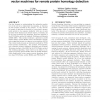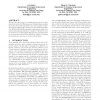127
Voted
RECOMB
2002
Springer
16 years 1 months ago
2002
Springer
We present an original approach to identifying sequence variants in a mixed DNA population from sequence trace data. The heart of the method is based on parsimony: given a wildtyp...
92
Voted
RECOMB
2002
Springer
16 years 1 months ago
2002
Springer
Proteins are involved either directly or indirectly in all biological processes in living organisms. It is now widely accepted that conformational changes of proteins can critical...
98
Voted
RECOMB
2002
Springer
16 years 1 months ago
2002
Springer
Biological data, such as gene expression profiles or protein sequences, is often organized in a hierarchy of classes, where the instances assigned to "nearby" classes in...
118
Voted
RECOMB
2002
Springer
16 years 1 months ago
2002
Springer
We present a probabilistic framework that models the process by which transcriptional binding explains the mRNA expression of different genes. Our joint probabilistic model unifie...
99
Voted
RECOMB
2002
Springer
16 years 1 months ago
2002
Springer
There are many critical situations when one needs to rapidly identify an unidentified pathogen from among a given set of previously sequenced pathogens. DNA or RNA hybridization c...
100
Voted
RECOMB
2002
Springer
16 years 1 months ago
2002
Springer
A recent idea for determining the three-dimensional structure of a protein uses antibody recognition of surface structure and random peptide libraries to map antibody epitope comb...
120
click to vote
RECOMB
2002
Springer
16 years 1 months ago
2002
Springer
One key element in understanding the molecular machinery of the cell is to understand the meaning, or function, of each protein encoded in the genome. A very successful means of i...
100
Voted
RECOMB
2002
Springer
16 years 1 months ago
2002
Springer
We introduce a model-based analysis technique for extracting and characterizing rhythmic expression pro les from genome-wide DNA microarray hybridization data. These patterns are ...
112
click to vote
RECOMB
2002
Springer
16 years 1 months ago
2002
Springer
We introduce the notion of a multiprofile and use it for finding subtle motifs in DNA sequences. Multiprofiles generalize the notion of a profile and allow one to detect subtle co...
103
Voted
RECOMB
2002
Springer
16 years 1 months ago
2002
Springer
This talk presents an algorithm to search for all approximate matches of a helix in a genome, where a helix is a combination of sequence and folding constraints. It is a joint wor...




